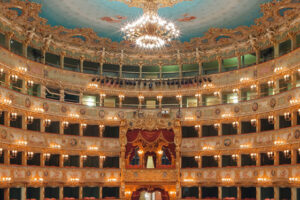

It was among the last of Donizetti’s completed works for the stage, and represents his skills in their full flower, with Donizetti’s usual and poignant mixture of almost slapdash haste and thoughtful melodic genius: Donizetti liked to claim that he had completed the work in eleven days, but in fact the score was the result of careful composition and revision stretching over more than three months, nothing like the prolonged gestations of Berlioz or Wagner, but suggestive of unusual deliberation on Donizetti’s part.
In this, it might be said, Donizetti found one of the best possible outlets for his remarkable facility, as he had in La Fille du Régiment and La Favorite. Generally indifferent to the finer points of his libretto, yet hungry for the situations and confrontations that fired his genius, Donizetti looked to a libretto already used by Stefano Pavesi, and asked Giovanni Ruffini to hammer it into shape.
The spectre that haunts Pasquale is that of the commedia dell’arte: Pasquale himself is a type of the old fool Pantalone, and his new name, from “Pasquin,” the much-abused fragmentary statue to which satirical verse used to be nailed, suggests that he is the deserving target of much abuse. His nephew Ernesto is the innocent Pierrot; Ernesto’s beloved Norina is the mercurial Columbine; and their ally Dr. Malatesta is the trickster Scapino, and his new name (“Headache”) suggests how little use his medicines are. The resulting libretto is a rather dismal reflection on the prospects of marriage, and it is interesting to reflect how often Donizetti was attracted to the notion of a woman stuck in a wretched relationship–Maria di Rohan; Favorite; Poliuto; Parisina.
Really, only a knife and a chemical imbalance separate the sprightly Norina from Lucia. The musical example–and challenge–of Mozart and Rossini are prominent here, and it is difficult to imagine Norina without the precedent of Rossini’s Rosina before her, or the patter of Malatesta and Pasquale’s “Aspetta, aspetta” without the precedent of Rossini’s trademark fireworks; yet the tone and example for Donizetti’s work here are more clearly found in the intermezzi of two generations back–Paisiello’s Serva Padrona and Cimarosa’s Matrimonio Segreto, with their small, controlled cast, suggested unit sets, and domestic scale. It is hard not to think, too, of many of the semiseria operas of the Baroque, with their succession of well-shaped arias and duets.
This summer’s production of the work by Boston Midsummer Opera was beautifully sung and played, and rather minimally presented. Leslie Ann Bradley was a remarkable Norina, lively and amusing; the slightest suggestion of a covered tone in the middle voice gave way quickly to a fine and flexible instrument, that became more beautiful and more individual as she went into her uppermost register.
David Kravitz as Malatesta was a magnetic stage presence, and competent for every challenge of Donizetti’s music; his performance was as much a credit to the opera this year as it was last year in BMO’s Italiana in Algieri. As Pasquale, Ricardo Lugo offered a powerful and convincing bass, although a certain woolliness of tone at times blurred his arpeggio work, while Alex Richardson as Ernesto exhibited both a sweetness of tone and fine squillo–a crucial talent for a bel canto tenor.
The costumes were an odd mixture of quasi-18th century and quasi-1950s styles. One wonders, looking at surviving images from the 1843 production, why they bothered; Pasquale himself dressed in a fool’s recollection of the fashions of his youth, decades before, and the other principals wore contemporary styles; nothing would have been lost by using carefully tailored 2010s-contemporary styles for this production.
Scenic designer Stephen Dobay‘s dull set for the first two acts blossomed imaginatively in the third, with tiers of opened parasols wittily representing the gardens around Pasquale’s house. As for the management of the stage action–Austin Pendleton, like many directors accustomed to plays rather than opera, seemed intimidated by the work, and fell back repeatedly on the expedient of parking the singers center stage and allowing them to sing squarely to the audience. Surely 2012–and Donizetti’s comic masterpiece–deserve more movement, variety, and imagination than this.
Richardson was especially ill-served here: the tenor role is the emotional heart of Donizetti’s comedies, as the soprano is the emotional heart of his tragedies, and to immobilize him, once again, downstage center, for “Cercherò lontana terra”; and then to bury him in darkness for “Com’è gentil,” is to miss something important about Donizetti. Special note should be made of Susan Davenny Wyner’s orchestra, which delivered a remarkably beatiful, clean, and sparkling sound throughout.
Although, overall, this production lacked the sparkle of last year’s Italiana in Algieri, that is only to be expected from the smaller scale of the opera itself, and perhaps the continuing impact of the recession on American arts organizations; Don Pasquale offered a fine night of comic opera with some of the field’s best younger singers.
Photo: Christopher McKenzie.

























Comments